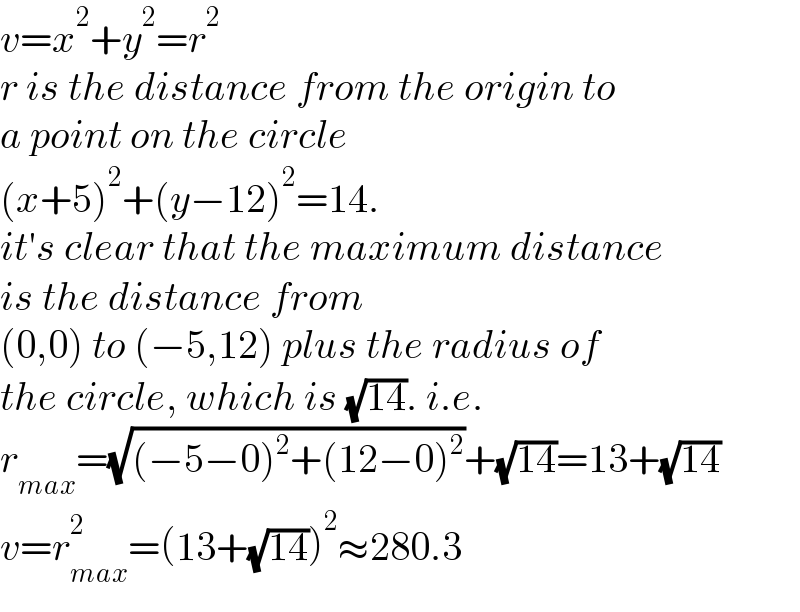
Question Number 169382 by infinityaction last updated on 29/Apr/22
![find the value of [v] if v denotes maximum value of x^2 + y^2 , where (x+5)^2 + (y−12)^2 = 14 (hint [•] repersent greatest integer function of “ •”)](Q169382.png)
$$\:\:\:\boldsymbol{\mathrm{find}}\:\boldsymbol{\mathrm{the}}\:\boldsymbol{\mathrm{value}}\:\boldsymbol{\mathrm{of}}\:\:\left[\boldsymbol{\mathrm{v}}\right]\:\boldsymbol{\mathrm{if}}\:\boldsymbol{\mathrm{v}}\:\boldsymbol{\mathrm{den}{o}\mathrm{tes}}\:\boldsymbol{\mathrm{maximum}}\:\: \\ $$$$\:\:\:\boldsymbol{\mathrm{value}}\:\boldsymbol{\mathrm{of}}\:\boldsymbol{\mathrm{x}}^{\mathrm{2}} \:+\:\boldsymbol{\mathrm{y}}^{\mathrm{2}} \:,\:\boldsymbol{\mathrm{where}}\:\left(\boldsymbol{\mathrm{x}}+\mathrm{5}\right)^{\mathrm{2}} \:+\:\left(\boldsymbol{\mathrm{y}}−\mathrm{12}\right)^{\mathrm{2}} \:=\:\mathrm{14} \\ $$$$\:\:\:\:\left(\boldsymbol{\mathrm{hint}}\:\left[\bullet\right]\:\boldsymbol{\mathrm{repersent}}\:\boldsymbol{\mathrm{greatest}}\:\boldsymbol{\mathrm{integer}}\:\boldsymbol{\mathrm{function}}\:\boldsymbol{\mathrm{of}}\:``\:\bullet''\right) \\ $$$$ \\ $$$$\: \\ $$
Commented by infinityaction last updated on 29/Apr/22

$${thank}\:{you}\:{sir}\:{and} \\ $$$${got}\:{my}\:{mistake} \\ $$
Commented by infinityaction last updated on 29/Apr/22

$${sir}\:{solution} \\ $$
Commented by mr W last updated on 29/Apr/22

$${v}={x}^{\mathrm{2}} +{y}^{\mathrm{2}} ={r}^{\mathrm{2}} \\ $$$${r}\:{is}\:{the}\:{distance}\:{from}\:{the}\:{origin}\:{to}\: \\ $$$${a}\:{point}\:{on}\:{the}\:{circle} \\ $$$$\left({x}+\mathrm{5}\right)^{\mathrm{2}} +\left({y}−\mathrm{12}\right)^{\mathrm{2}} =\mathrm{14}. \\ $$$${it}'{s}\:{clear}\:{that}\:{the}\:{maximum}\:{distance} \\ $$$${is}\:{the}\:{distance}\:{from} \\ $$$$\left(\mathrm{0},\mathrm{0}\right)\:{to}\:\left(−\mathrm{5},\mathrm{12}\right)\:{plus}\:{the}\:{radius}\:{of} \\ $$$${the}\:{circle},\:{which}\:{is}\:\sqrt{\mathrm{14}}.\:{i}.{e}. \\ $$$${r}_{{max}} =\sqrt{\left(−\mathrm{5}−\mathrm{0}\right)^{\mathrm{2}} +\left(\mathrm{12}−\mathrm{0}\right)^{\mathrm{2}} }+\sqrt{\mathrm{14}}=\mathrm{13}+\sqrt{\mathrm{14}} \\ $$$${v}={r}_{{max}} ^{\mathrm{2}} =\left(\mathrm{13}+\sqrt{\mathrm{14}}\right)^{\mathrm{2}} \approx\mathrm{280}.\mathrm{3} \\ $$
Commented by greougoury555 last updated on 29/Apr/22
![⇒v = (√(14)) +(√((−5)^2 +12^2 )) = 13+(√(14)) ⇒ [ v ] = 16](Q169385.png)
$$\:\Rightarrow{v}\:=\:\sqrt{\mathrm{14}}\:+\sqrt{\left(−\mathrm{5}\right)^{\mathrm{2}} +\mathrm{12}^{\mathrm{2}} }\:=\:\mathrm{13}+\sqrt{\mathrm{14}} \\ $$$$\Rightarrow\:\left[\:{v}\:\right]\:=\:\mathrm{16}\: \\ $$
Commented by infinityaction last updated on 29/Apr/22

$${use}\:{circle}\:{equation} \\ $$$${same}\:{solution}\:{sir}\: \\ $$$${btw}\:{thanks}\: \\ $$
Commented by infinityaction last updated on 29/Apr/22
![but sir i am confused because let x= −5 and y = (√(14)) +12 then x^2 + y^2 = 272.799 [x^2 +y^2 ]= [272.799] = 272](Q169387.png)
$${but}\:{sir}\:{i}\:{am}\:{confused} \\ $$$${because}\:{let}\:{x}=\:−\mathrm{5}\:{and}\:{y}\:=\:\sqrt{\mathrm{14}}\:+\mathrm{12} \\ $$$${then}\:{x}^{\mathrm{2}} +\:{y}^{\mathrm{2}} \:=\:\mathrm{272}.\mathrm{799} \\ $$$$\left[{x}^{\mathrm{2}} +{y}^{\mathrm{2}} \right]=\:\left[\mathrm{272}.\mathrm{799}\right]\:=\:\mathrm{272} \\ $$
Commented by mr W last updated on 29/Apr/22
![v=(13+(√(14)))^2 ≈280.3 [v]=280](Q169388.png)
$${v}=\left(\mathrm{13}+\sqrt{\mathrm{14}}\right)^{\mathrm{2}} \approx\mathrm{280}.\mathrm{3} \\ $$$$\left[{v}\right]=\mathrm{280} \\ $$
Answered by kapoorshah last updated on 29/Apr/22
![let x + 5 = (√(14)) cos α y − 12 = (√(14)) sin α x^2 + y^2 = ((√(14)) cos α − 5)^2 + ((√(14)) sin α + 12)^2 = 14 − 10(√(14)) cos α + 24(√(14)) sin α + 169 = 183 + 26(√(14)) cos (α − tan^(−1) (− ((12)/5))) [v] = 183 + 26(√(14)) ≈ 280,283](Q169395.png)
$${let}\:\:\:{x}\:+\:\mathrm{5}\:=\:\sqrt{\mathrm{14}}\:\mathrm{cos}\:\alpha \\ $$$${y}\:−\:\mathrm{12}\:=\:\sqrt{\mathrm{14}}\:\mathrm{sin}\:\alpha \\ $$$${x}^{\mathrm{2}} \:+\:{y}^{\mathrm{2}} \:=\:\left(\sqrt{\mathrm{14}}\:\mathrm{cos}\:\alpha\:−\:\mathrm{5}\right)^{\mathrm{2}} \:+\:\left(\sqrt{\mathrm{14}}\:\mathrm{sin}\:\alpha\:+\:\mathrm{12}\right)^{\mathrm{2}} \\ $$$$\:\:\:\:\:\:\:\:\:\:\:\:\:\:\:\:=\:\mathrm{14}\:−\:\mathrm{10}\sqrt{\mathrm{14}}\:\mathrm{cos}\:\alpha\:+\:\mathrm{24}\sqrt{\mathrm{14}}\:\mathrm{sin}\:\alpha\:+\:\mathrm{169} \\ $$$$\:\:\:\:\:\:\:\:\:\:\:\:\:\:\:\:=\:\mathrm{183}\:+\:\mathrm{26}\sqrt{\mathrm{14}}\:\mathrm{cos}\:\left(\alpha\:−\:\mathrm{tan}^{−\mathrm{1}} \left(−\:\frac{\mathrm{12}}{\mathrm{5}}\right)\right) \\ $$$$\left[{v}\right]\:=\:\mathrm{183}\:+\:\mathrm{26}\sqrt{\mathrm{14}} \\ $$$$\:\:\:\:\:\:\:\approx\:\mathrm{280},\mathrm{283} \\ $$
Commented by infinityaction last updated on 29/Apr/22

$${thank}\:{you} \\ $$
